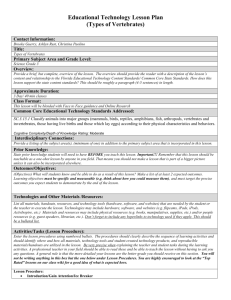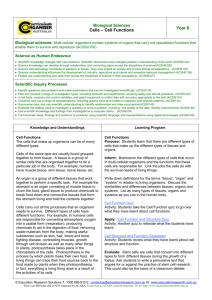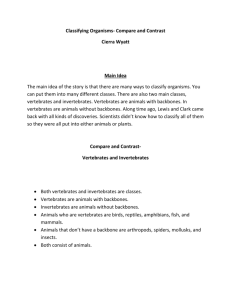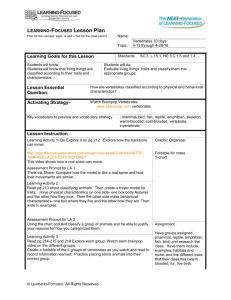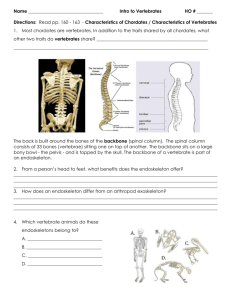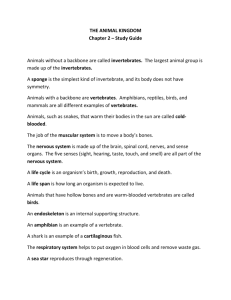Classification - vertebrates
advertisement
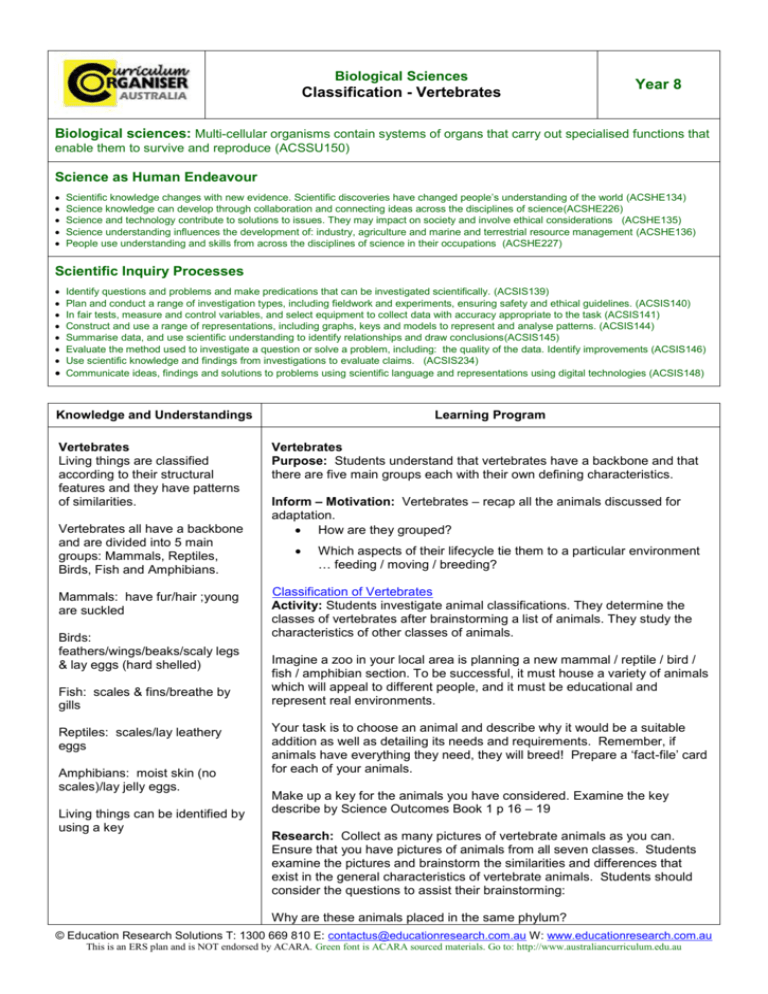
Biological Sciences Classification - Vertebrates Year 8 Biological sciences: Multi-cellular organisms contain systems of organs that carry out specialised functions that enable them to survive and reproduce (ACSSU150) Science as Human Endeavour Scientific knowledge changes with new evidence. Scientific discoveries have changed people’s understanding of the world (ACSHE134) Science knowledge can develop through collaboration and connecting ideas across the disciplines of science(ACSHE226) Science and technology contribute to solutions to issues. They may impact on society and involve ethical considerations (ACSHE135) Science understanding influences the development of: industry, agriculture and marine and terrestrial resource management (ACSHE136) People use understanding and skills from across the disciplines of science in their occupations (ACSHE227) Scientific Inquiry Processes Identify questions and problems and make predications that can be investigated scientifically. (ACSIS139) Plan and conduct a range of investigation types, including fieldwork and experiments, ensuring safety and ethical guidelines. (ACSIS140) In fair tests, measure and control variables, and select equipment to collect data with accuracy appropriate to the task (ACSIS141) Construct and use a range of representations, including graphs, keys and models to represent and analyse patterns. (ACSIS144) Summarise data, and use scientific understanding to identify relationships and draw conclusions(ACSIS145) Evaluate the method used to investigate a question or solve a problem, including: the quality of the data. Identify improvements (ACSIS146) Use scientific knowledge and findings from investigations to evaluate claims. (ACSIS234) Communicate ideas, findings and solutions to problems using scientific language and representations using digital technologies (ACSIS148) Knowledge and Understandings Vertebrates Living things are classified according to their structural features and they have patterns of similarities. Vertebrates all have a backbone and are divided into 5 main groups: Mammals, Reptiles, Birds, Fish and Amphibians. Mammals: have fur/hair ;young are suckled Birds: feathers/wings/beaks/scaly legs & lay eggs (hard shelled) Fish: scales & fins/breathe by gills Reptiles: scales/lay leathery eggs Amphibians: moist skin (no scales)/lay jelly eggs. Living things can be identified by using a key Learning Program Vertebrates Purpose: Students understand that vertebrates have a backbone and that there are five main groups each with their own defining characteristics. Inform – Motivation: Vertebrates – recap all the animals discussed for adaptation. How are they grouped? Which aspects of their lifecycle tie them to a particular environment … feeding / moving / breeding? Classification of Vertebrates Activity: Students investigate animal classifications. They determine the classes of vertebrates after brainstorming a list of animals. They study the characteristics of other classes of animals. Imagine a zoo in your local area is planning a new mammal / reptile / bird / fish / amphibian section. To be successful, it must house a variety of animals which will appeal to different people, and it must be educational and represent real environments. Your task is to choose an animal and describe why it would be a suitable addition as well as detailing its needs and requirements. Remember, if animals have everything they need, they will breed! Prepare a ‘fact-file’ card for each of your animals. Make up a key for the animals you have considered. Examine the key describe by Science Outcomes Book 1 p 16 – 19 Research: Collect as many pictures of vertebrate animals as you can. Ensure that you have pictures of animals from all seven classes. Students examine the pictures and brainstorm the similarities and differences that exist in the general characteristics of vertebrate animals. Students should consider the questions to assist their brainstorming: Why are these animals placed in the same phylum? © Education Research Solutions T: 1300 669 810 E: contactus@educationresearch.com.au W: www.educationresearch.com.au This is an ERS plan and is NOT endorsed by ACARA. Green font is ACARA sourced materials. Go to: http://www.australiancurriculum.edu.au What characteristics are used to separate these animals into different classes? The results of the brainstorm can be recorded in any way the students feel is appropriate and the information shared with the rest of the class. Students need to choose TWO of the following characteristics and research how this varies across the five (the three classes of fish can be considered together) main classes of vertebrates: Type of body covering. Method of obtaining oxygen. Ability to regulate body temperature. The way in which the young are born and cared for. Habitat(s) in which they live. This information should be presented as a brief scientific report. Evaluate – Generalise: Invertebrates and Vertebrate Evolution Activity: Students explore the major characteristics of the major animal phyla. They describe adaptive features that have contributed to the success of animals on land. Students explain how primate evolution provides a context for understanding human origins. They participate in a game to match animal’s characteristics to their phylum or class. Assessment: Research an animal for a zoo and create a classification key for all of the animals chosen by the class. Create and critically analyse a collage of vertebrates. Create a brief scientific report on how different characteristics vary across the five categories of vertebrates. Standards http://www.australiancurriculum.edu.au/Science/Curriculum/F-10?y=8&s=SU&s=HE&s=IS&layout=1 Teacher Resources IWB T KidPort: Vertebrates photos, facts, links Student Resources IWB S © Education Research Solutions T: 1300 669 810 E: contactus@educationresearch.com.au W: www.educationresearch.com.au This is an ERS plan and is NOT endorsed by ACARA. Green font is ACARA sourced materials. Go to: http://www.australiancurriculum.edu.au Lesson Planner Lesson Teacher Notes Student Activities Resources Title: 1 Date Time Title: 2 Date Time Title: 3 Date Time Title: 4 Date Time Title: 5 Date Time © Education Research Solutions T: 1300 669 810 E: contactus@educationresearch.com.au W: www.educationresearch.com.au This is an ERS plan and is NOT endorsed by ACARA. Green font is ACARA sourced materials. Go to: http://www.australiancurriculum.edu.au


